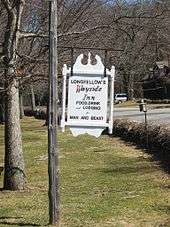Wayside Inn Historic District
The Wayside Inn Historic District is a historic district on Old Boston Post Road in Sudbury, Massachusetts. The district contains the famous Wayside Inn, a historic landmark inn that is reputedly the oldest continually operating inn in the country, opening as Howe's Tavern in 1716.[2] The district features Greek Revival and Colonial architecture. The area was added to the National Register of Historic Places in 1973.
Wayside Inn Historic District | |
 | |
  | |
| Location | Sudbury, Massachusetts |
|---|---|
| Coordinates | 42°21′28″N 71°28′5″W |
| Built | 1700 |
| Architect | Multiple |
| Architectural style | Greek Revival, Colonial |
| NRHP reference No. | 73000307 [1] |
| Added to NRHP | April 23, 1973 |
The Wayside Inn
The inn's archive has documents from 1686 onward, including the official inn license granted to the first innkeeper, David Howe, in 1716. His son, Ezekiel Howe, was the next innkeeper and fought in the American Revolution with the Sudbury Minutemen.[3] Lydia Howe, a granddaughter, was born in the Inn. The inn is also known as "Longfellow's Wayside Inn", a name given to the inn to capitalize on the popularity of Henry Wadsworth Longfellow's "Tales of a Wayside Inn", a book of poems published in 1863. Longfellow visited the Wayside Inn in 1862, when it was called the "How Tavern". In his book "Tales of a Wayside Inn", Longfellow republished his poem "Paul Revere's Ride" as "The Landlord's Tale".
Two slaves are known to have lived at the inn: a man named "Portsmouth" and an unnamed girl were purchased in 1773 and 1779, respectively, by Ezekiel Howe.[4]
Henry Ford was the last private owner of the Wayside Inn. He purchased it in 1923, from Cora Lemon, and he also purchased 3,000 acres (12 km²) of land surrounding the Inn, with the aim of developing it into a historically oriented village and museum. Although his original aims were not accomplished at the Wayside, he did establish the non-profit institution that operates the Inn and associated museum, watermill, and archives today. He also established the Wayside Inn Boys School, a trade school which operated from 1928-1947, aiming to demonstrate his belief that "the only way to really learn is by doing."[5] Ford sold the Wayside property in 1945, ultimately fulfilling his desires to create such a museum at Greenfield Village in Dearborn, Michigan.[6] The inn is still in operation, offering a restaurant, historically accurate guest rooms, and hosting for small receptions. The original building burned down in 1955 and was rebuilt with many original beams and pieces shortly thereafter. A room in the inn (room 9) is still said to be haunted by a female relative of the original inn-keeper(Howe)and she eternally waits for her husband to return from England.
Martha-Mary Chapel
Henry Ford built a replica and fully working grist mill and a white non-denominational church, named after his mother, Mary, and mother in law, Martha. Less well known is Ford's attempt to create a reservoir for the Wayside Inn. Across US Rte. 20 and now secluded in a wooded area behind private homes is a 30 ft. high stone dam. Dubbed by the locals as "Ford's Folly" the structure failed to retain water because the feeding brook provided insufficient volume and the ground was too porous for a pond to fill.
In the grounds of the church stands a one-room schoolhouse that was moved there from its original location in Sterling, Massachusetts by Ford, who believed the building was the actual schoolhouse mentioned in Sarah Josepha Hale's poem "Mary Had a Little Lamb", though little historical evidence exists to support his belief.
Gallery

 The main entrance of the inn
The main entrance of the inn
 A marker announcing George Washington's passing through in 1775
A marker announcing George Washington's passing through in 1775 The Wayside Inn, c. 1935
The Wayside Inn, c. 1935- The inn's grist mill
References
- "National Register Information System". National Register of Historic Places. National Park Service. April 15, 2008.
- Historic Homes and Genealogical memoirs of Early New England pg 281-283 publ 1909 by Ellery Bicknell Crane
- Harris, Patricia; Lyon, David (2005-12-11). "Sudbury inn's cocktail of history and comfort". Boston.com. Retrieved 2020-06-22.
- Plumb, Brian E. (2011-11-04). A History of Longfellow's Wayside Inn. Arcadia Publishing. ISBN 978-1-61423-848-5.
- Henry Ford's Boys: the story of the Wayside Inn Boys School, Curtis F. Garfield and Alison R. Ridley, Porcupine Enterprises, 1998, page 1
- Wayside Inn History. Retrieved May 2008.
| Wikimedia Commons has media related to Longfellow's Wayside Inn. |
